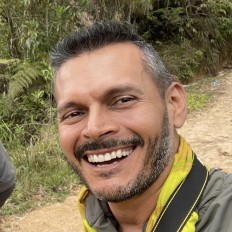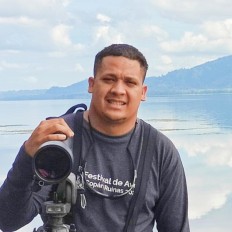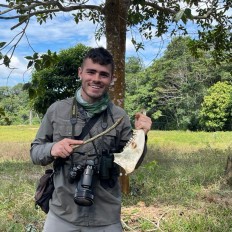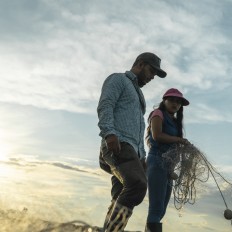Top species
- Black-bellied Cuckoo (Piaya melanogaster)
- Ladder-tailed Nightjar (Hydropsalis climacocerca)
- Boat-billed Heron (Cochlearius cochlearius)
- Agami Heron (Agamia agami)
- Harpy Eagle (Harpia harpyja)
- Pavonine Quetzal (Pharomachrus pavoninus)
- Great Jacamar (Jacamerops aureus)
- Golden-collared Toucanet (Selenidera reinwardtii)
- Cocha Antshrike (Thamnophilus praecox)
- Silvered Antbird (Sclateria naevia)
- White-plumed Antbird (Pithys albifrons)
- Hairy-crested Antbird (Rhegmatorhina melanosticta)
- Black-spotted Bare-eye (Phlegopsis nigromaculata)
- Spotted Antpitta (Hylopezus macularius)
- Black-necked Red-Cotinga (Phoenicircus nigricollis)
- Cinereous Mourner (Laniocera hypopyrra)
List up to ca. 25 species that:
• have a limited distribution range and/or are rare on a global level
• are most sought-after by birdwatchers at this site
• and are relatively easy to see at this site (year-round or seasonally)
| Black-bellied Cuckoo (Piaya melanogaster) | |
| Ladder-tailed Nightjar (Hydropsalis climacocerca) | |
| Boat-billed Heron (Cochlearius cochlearius) | |
| Agami Heron (Agamia agami) | |
| Harpy Eagle (Harpia harpyja) | |
| Pavonine Quetzal (Pharomachrus pavoninus) | |
| Great Jacamar (Jacamerops aureus) | |
| Golden-collared Toucanet (Selenidera reinwardtii) | |
| Cocha Antshrike (Thamnophilus praecox) | |
| Silvered Antbird (Sclateria naevia) | |
| White-plumed Antbird (Pithys albifrons) | |
| Hairy-crested Antbird (Rhegmatorhina melanosticta) | |
| Black-spotted Bare-eye (Phlegopsis nigromaculata) | |
| Spotted Antpitta (Hylopezus macularius) | |
| Black-necked Red-Cotinga (Phoenicircus nigricollis) | |
| Cinereous Mourner (Laniocera hypopyrra) |
Agami Heron (Agamia agami) was added by Jorge Muñoz García (2023-10-19 11:44:05)
Cinereous Mourner (Laniocera hypopyrra) was added by Jorge Muñoz García (2023-10-19 11:43:34)
Harpy Eagle (Harpia harpyja) was added by Jorge Muñoz García (2023-10-19 11:42:50)
Silvered Antbird (Sclateria naevia) was added by Jorge Muñoz García (2023-06-28 15:30:58)
Great Jacamar (Jacamerops aureus) was added by Jorge Muñoz García (2022-08-24 22:50:08)
Black-bellied Cuckoo (Piaya melanogaster) was added by Jorge Muñoz García (2022-08-24 22:49:57)
Pavonine Quetzal (Pharomachrus pavoninus) was added by Jorge Muñoz García (2022-08-24 22:49:43)
Golden-collared Toucanet (Selenidera reinwardtii) was added by Jorge Muñoz García (2022-08-24 22:49:32)
Boat-billed Heron (Cochlearius cochlearius) was added by Jorge Muñoz García (2022-08-24 22:47:31)
White-plumed Antbird (Pithys albifrons) was added by Jorge Muñoz García (2021-09-28 02:02:46)
Black-spotted Bare-eye (Phlegopsis nigromaculata) was added by Jorge Muñoz García (2021-09-28 02:02:16)
Hairy-crested Antbird (Rhegmatorhina melanosticta) was added by Jorge Muñoz García (2021-09-28 02:01:04)
Cocha Antshrike (Thamnophilus praecox) was added by Jorge Muñoz García (2021-09-28 01:58:27)
Ladder-tailed Nightjar (Hydropsalis climacocerca) was added by Jorge Muñoz García (2021-09-28 01:45:36)
Black-necked Red-Cotinga (Phoenicircus nigricollis) was added by Jorge Muñoz García (2021-09-28 01:44:34)
Spotted Antpitta (Hylopezus macularius) was added by Jorge Muñoz García (2021-09-28 01:44:08)





